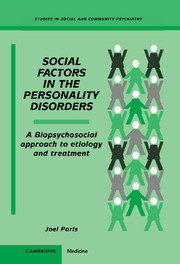Book contents
- Frontmatter
- Contents
- Foreword
- Introduction
- Acknowledgments
- 1 Overview
- 2 Personality Traits and Personality Disorders
- 3 Biological Factors
- 4 Psychological Factors
- 5 Social Factors – Methods
- 6 Social Factors – Mechanisms
- 7 A Biopsychosocial Model of the Personality Disorders
- 8 The Odd Cluster
- 9 The Impulsive Cluster
- 10 The Anxious Cluster
- 11 Treatment
- 12 Clinical Practice
- Epilogue: Summary and Research Implications
- References
- Index
2 - Personality Traits and Personality Disorders
Published online by Cambridge University Press: 05 May 2010
- Frontmatter
- Contents
- Foreword
- Introduction
- Acknowledgments
- 1 Overview
- 2 Personality Traits and Personality Disorders
- 3 Biological Factors
- 4 Psychological Factors
- 5 Social Factors – Methods
- 6 Social Factors – Mechanisms
- 7 A Biopsychosocial Model of the Personality Disorders
- 8 The Odd Cluster
- 9 The Impulsive Cluster
- 10 The Anxious Cluster
- 11 Treatment
- 12 Clinical Practice
- Epilogue: Summary and Research Implications
- References
- Index
Summary
The nature and origin of personality traits
Every individual has a set of unique behavioral characteristics, popularly called “personality”. Psychologists define personality traits as consistent patterns of behavior, emotion, and cognition. These characteristics vary greatly between one individual and another. Personality traits can be identified early in life, and are highly stable over time. The broadest characteristics of personality change very little between the ages of 18 and 60 (McCrae & Costa, 1990).
Let us consider an example. Perhaps the most basic of all individual differences in personality is extraversion vs. introversion (McCrae & Costa, 1990; Eysenck, 1991). Extraverts need to be around people, and require a higher level of stimulation. Introverts need more time alone, and require a lower level of stimulation. These differences are rooted in temperament. Extraverts and introverts, if they go on to develop personality pathology, will have different types of disorders.
Both genetic and environmental factors play a role in shaping personality. Rutter (1987) suggested that two factors influence the development of traits: temperament and social learning. Temperament describes those behavioral dispositions present at birth. Observations of newborn- infants show that they differ from each other in how active they are, in how sociable they are, in how easily they get upset, and in how readily they can be calmed down (Kagan, 1994).
Within normal ranges, infantile temperament is not notably continuous with later personality. The only consistent finding of long-term follow-up studies of children with different temperamental dispositions is that a “difficult” temperament, i.e., being easily upset and hard to calm down, makes psychopathology in adulthood more likely (Chess & Thomas, 1990).
- Type
- Chapter
- Information
- Social Factors in the Personality DisordersA Biopsychosocial Approach to Etiology and Treatment, pp. 18 - 30Publisher: Cambridge University PressPrint publication year: 1996

